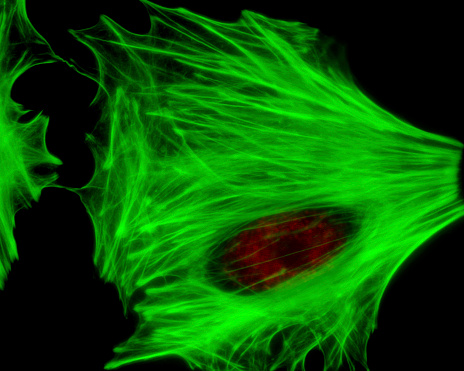
创新背景
细胞功能退化带来人体衰老,随之而来的是皮肤褶皱、机体功能下降、免疫机制破坏等引起的一系列疾病。科学家们不断在分子领域进行细胞生物学研究想要延迟衰老,减少人体衰老带来的疾病。
2012年、日本京都大学教授山中伸弥以干细胞重编程技术获得诺贝尔奖生理学或医学奖。这项技术是基于把成年体细胞重新诱导回早期干细胞状态,以用于形成各种类型的细胞,将体细胞转化为诱导多能干细胞(IPSC)的过程,可以帮助逆转与年龄有关的变化。但在IPSC重编程过程中,因为重新分化的IPSC并不是成熟的成人细胞,而是类似胎儿的细胞,体细胞容易丢失且难以重获,细胞特性难以维持。并且,重编过程大约需要耗时50天,使用到四个被称为“山中因子”的关键分子。
创新过程
2022年4月8日,英国剑桥大学领导的研究团队在《eLife》上发表了《通过成熟期瞬时重编程实现人类细胞的多组学复兴》的研究,是一项基于体细胞重编技术发展而来的“成熟期瞬时重编程”的新技术,重编过程仅需13天。新技术在细胞重编和保持特异性之间精准平衡,干细胞重新分化的过程中保证细胞不是完全被重编,部分可以停止重编,保证细胞特异性留存。被重编程的皮肤细胞在逆转衰老的同时,保留了专门使其成为皮肤细胞的功能。
研究人员表示,在过去十年在分子水平上对衰老的理解取得了许多进展,并产生了一些使研究人员能够测量细胞中与年龄有关的生物变化的技术。将这些技术用于我们的实验,帮助确定新方法所实现的重编程的程度。
研究观察了表观遗传时钟和转录组两种细胞年龄的衡量标准。通过两种衡量标准,重编程的细胞与参考数据集相比,符合较之年轻 30 岁的细胞的特征。研究人员在一种新的转录组时钟测量中发现,转录组恢复了大约30岁;包括H3K9me3组蛋白甲基化水平和DNA甲基化衰老时钟的表观基因组也在类似程度上恢复了活力。
此外,成熟期瞬时重编程成纤维细胞产生了年轻标准水平胶原蛋白。成纤维细胞是一种存在于骨骼、皮肤肌腱和韧带中的分子,有助于为组织提供结构并治愈伤口。成纤维细胞经过重新编程恢复活力,产生了更多的胶原蛋白,成纤维细胞也会移动到需要修复的区域。研究人员在一个培养皿的细胞层中制造了一个人工切口,用来测试部分恢复活力的细胞。他们发现,被重编后的成纤维细胞比衰老细胞更快地移动到缺口处。该迹象表明此项研究技术在未来很可能为愈合伤口创造细胞并扩展医学治疗。
目前,成熟期瞬时重编背后的机制尚需进一步探索,研究人员推测,参与塑造细胞身份的基因组关键区域可能会逃脱重编程过程。
根据研究人员观察,新技术方法对其他与年龄相关疾病和症状有关的基因也产生影响,APBA2基因和MAF基因都显示出向年轻水平的转录变化。成熟期瞬时重编的进一步探索对衰老的研究和医学或许会引发巨大变革。
创新关键点
基于干细胞重编程技术进行细胞年龄深度观察和成纤维细胞重编,深化细胞重编程技术。
Transient reprogramming at maturity may reverse skin aging
On April 8, 2022, a research team led by the University of Cambridge published the study "multi-omic rejuvenation of human cells by maturation phase transient reprogramming" in eLife, which is a new technology of "transient reprogramming at maturity" based on somatic cell reprogramming technology. The reprogramming process only takes 13 days. The new technology achieves a precise balance between cell reprogramming and maintaining specificity. During the process of stem cell redifferentiation, it ensures that cells are not completely reprogrammed, and part of the reprogramming can be stopped to ensure the retention of cell specificity. The reprogrammed skin cells reverse aging while retaining the functions that make them skin cells.
The researchers say that many advances in the understanding of aging at the molecular level over the past decade have resulted in techniques that allow researchers to measure age-related biological changes in cells. These techniques were used in our experiments to help determine the extent of reprogramming achieved by the new approach.
The study looked at the epigenetic clock and the transcriptome, two measures of cellular age. By two measures, the reprogrammed cells matched the characteristics of cells 30 years younger than the reference dataset. In a new measure of the transcriptome clock, the researchers found that the transcriptome was restored by about 30 years; the epigenome, which includes H3K9me3 histone methylation levels and DNA methylation, the aging clock was similarly restored.
In addition, transiently reprogrammed fibroblasts during maturation produced youth-standard levels of collagen. Fibroblasts are molecules found in bones, skin, tendons, and ligaments that help provide structure to tissues and heal wounds. Fibroblasts are reprogrammed to rejuvenate, producing more collagen, and fibroblasts move to areas that need repair. The researchers made an artificial cut in the cell layer of a petri dish to test partially rejuvenated cells. They found that reprogrammed fibroblasts moved into the gap faster than senescent cells. This is an indication that the research technique has the potential to create cells for healing wounds and expand medical treatments in the future.
At present, the mechanisms behind transient reprogramming during maturation need to be further explored, and the researchers speculate that key regions of the genome involved in shaping cellular identity may escape the reprogramming process.
According to the researchers, the new technique also had an effect on other genes associated with age-related diseases and symptoms, with both the APBA2 gene and the MAF gene showing transcriptional changes towards younger levels. Further exploration of transient reprogramming of maturation could lead to dramatic changes in aging research and medicine.
智能推荐
美国认知神经科学学会Michael Gazzanigas演讲:意识的本能(1)
2022-09-14认知神经科学协会(CNS)致力于发展思维和大脑研究,旨在研究认知的心理,计算和神经科学基础,认知神经科学这个词现在已经存在了将近三十年,它确定了一种跨学科的方法 来理解思想的本质。认知神经科学学会每年春季都举行一次年度会议。会议的目的是召集来自世界各地的研究人员,以分享认知神经科学方面的最新研究。
涉及学科涉及领域研究方向创新发现T细胞耗竭前的自我更新机制
2022-08-29来自慕尼黑大学及墨尔本大学的研究团队深入研究了TPEX 细胞。这项研究成果不仅解释了为什么免疫疗法对某些患者无效,而且还为开发针对癌症或严重病毒感染更有效的免疫疗法提供了重要信息。
涉及学科涉及领域研究方向生物医学理论创新 | 医学治疗昏迷要从意识研究入手
2022-08-01从昏迷的难题——意识障碍入手,研究生理意义上的意识问题,将昏迷纳入医疗考虑,探究昏迷和意识的本质。
涉及学科涉及领域研究方向植入颅内的超声设备帮助治疗阿尔兹海默症
2022-06-28法国CarThera公司研发的SonoCloud是一种植入颅内的超声设备,该设备能通过低强度超声暂时打开血脑屏障(BBB),增加大脑中血管的通透性,提高化疗药物的利用度,从而减少β-淀粉样蛋白和tau蛋白,改善阿尔兹海默症患者的认知表现。
涉及学科涉及领域研究方向